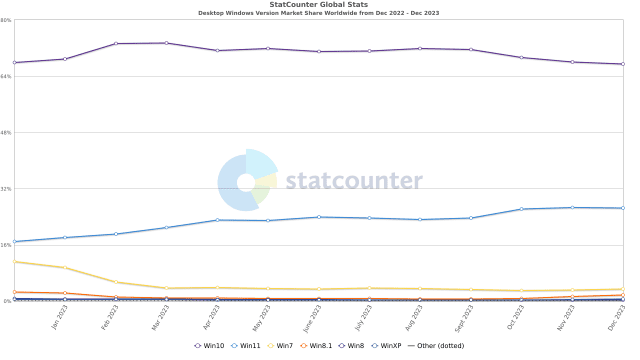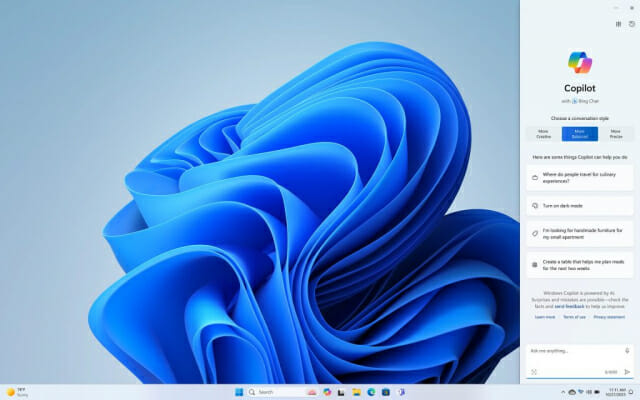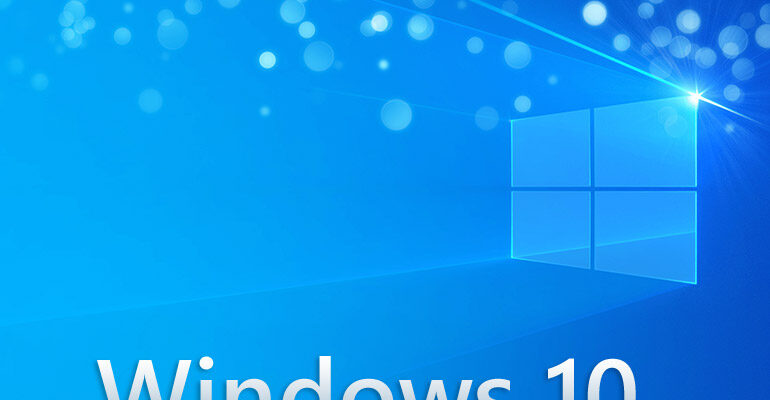Will the end of support for Windows 10 by Microsoft, announced for October 14, 2025, be a delicate turn to negotiate for the Redmond giant? More than two years after the release of Windows 11, Windows 10’s market share seems to be holding up.
According to StatCounter’s latest operating system (OS) market share data, Windows 10 remains the top desktop operating system as of December last year, with a market share of 67.42%.

The latest version, Windows 11, holds 26.52% market share. Windows 7, which is no longer supported by Microsoft, at 3.34% market share, Windows 8.1 1.66% and Windows XP 0.64%.
Windows 11 slower than Windows 10
Across all desktop operating systems, Windows has a 72.79% market share. Apple’s macOS system comes in second place.
As the operating system market has shifted from desktop to mobile devices over time, and PC replacement cycles have lengthened, Windows 10 has taken a long time to emerge from the shadow of Windows 7 and Windows 8.1. Windows 10 even had to compete with Windows XP. But two years after its launch, Windows 10 had exceeded 30% market share and had exceeded the market share of Windows 7.
Windows 11 has been slower to gain market share than Windows 10.
Windows 11: a garbled message
Windows 11 was launched in October 2021. Two years after its release, it still has not crossed the 30% market share mark. Windows 11 started at 16.97% in December 2022 and only gained 9.47% in December 2023.
Windows 10’s market share was 67.95% in December 2022, and it even increased in January and February 2023. In the end, in one year, Windows 10 only lost 0.53% of its market share. walk.
This stagnation of Windows 11 is largely due to Microsoft’s strict hardware requirements to run Windows 11.
Microsoft Copilot finally on Windows 10
True, Microsoft offered Windows 10 users a free upgrade to Windows 11. However, the upgrade was limited to those who met the hardware requirements. Microsoft and manufacturers expected this to boost demand for replacing Windows 7 or Windows 10-based PCs with new PCs. But demand was not as great as expected.
For what ? Because while Microsoft strictly limits hardware requirements for performance and security reasons, it doesn’t seem to do enough to help users choose. Windows 11 can indeed be installed on older PCs even if they do not pass hardware compatibility tests. And most importantly, there is no perception that Windows 11 is significantly better than Windows 10.
Microsoft hasn’t released a major Windows 10 update since October 2022, and only Windows 11 was expected to include Microsoft Copilot, a generative artificial intelligence (AI) feature. By reserving artificial intelligence functions for Windows 11, the company hoped to convince users to upgrade to the latest version of the OS.
Departure of Panos Panay and change of strategy
However, in November last year, Microsoft reversed course, and reversed its position by announcing that it would integrate Copilot into Windows 10.
This change in position is likely related to a change in the direction of development of the Windows operating system.
In September of last year, Panos Panay, the executive vice president who oversaw Microsoft’s Windows and Surface hardware businesses, abruptly resigned and left for Amazon.
Windows 10 and Windows 11: the same platform?
Panos Panay was replaced by Yousuf Mehdi, executive vice president and head of consumer marketing. Windows 11 and device development and releases are now led by company VP Pavan Baruluri, while the Windows and Web Experience team is led by VP Mikhail Farakin, who worked on Bing Cat.
Panos Panay, who originally handled development of Surface hardware, had taken over the Windows business as part of a reorganization that followed the departure of the head of Windows in 2021. But versions of Windows for New form factors, such as dual and foldable screens, were heavily invested in, and failed. Before his departure, Mr. Panay had expressed frustration with calls from other company executives to focus on the core platform.

Panos Panay’s successors seem to consider Windows 10 and Windows 11 to be practically the same platform. The rationale for this shift in stance is that Windows 10’s absolute dominance as the mainstream’s channel for generative AI services is hard to ignore.
And what about Windows 12?
This year, Microsoft must make very significant changes to Windows 11.
Microsoft must remove the default Edge browser and Bing search in Windows 10 22H2 and Windows 11 23H2 in the European Union by March 6 this year. Therefore, the latest Windows 10 and Windows 11 updates will be available soon with the ability to remove Bing and Edge.
Meanwhile, a Windows 11 update or the release of Windows 12 is expected later this year. This will coincide with the release of Intel’s processors for AI PCs and new processors from Qualcomm. Microsoft hopes to make this a turning point for the new Windows.
In October of this year, Windows 10 will be one year from the end of technical support. Large businesses facing a mandatory PC replacement cycle should start buying new hardware in earnest.
Source: “ZDNet Korea”
